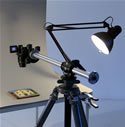Any 14.1 or 1P players out there that would like to study various combination shots in a rack?
My idea would be to setup a tripod next to the table with a camera arm that would allow the camera to be suspended directly over the rack. You would video the rack as you try various combinations and play back the recordings in slow motion (probably on a computer monitor screen) in order to see what the naked eye is unable to see at normal speed. I don’t imagine it would require really sophisticated equipment like Dr. Dave might use for his high speed videos because I don’t think the playback would need to be as slow for this purpose.
Not being a photography expert, I’ve got a number of questions:
1. What kind of tripod setup might work best? I’m guessing the tripod would have to be able to suspend the camera well over the table and enable it to shoot in a downward direction.
2. How much of camera would it take to capture a video that is sufficient to be played back at a relatively slow speed so that it is easy to see what’s going on with the balls?
3. Anything else needed?
4. How much is this kind of experiment likely to cost?
5. Do you think it would actually work as intended?
My idea would be to setup a tripod next to the table with a camera arm that would allow the camera to be suspended directly over the rack. You would video the rack as you try various combinations and play back the recordings in slow motion (probably on a computer monitor screen) in order to see what the naked eye is unable to see at normal speed. I don’t imagine it would require really sophisticated equipment like Dr. Dave might use for his high speed videos because I don’t think the playback would need to be as slow for this purpose.
Not being a photography expert, I’ve got a number of questions:
1. What kind of tripod setup might work best? I’m guessing the tripod would have to be able to suspend the camera well over the table and enable it to shoot in a downward direction.
2. How much of camera would it take to capture a video that is sufficient to be played back at a relatively slow speed so that it is easy to see what’s going on with the balls?
3. Anything else needed?
4. How much is this kind of experiment likely to cost?
5. Do you think it would actually work as intended?
